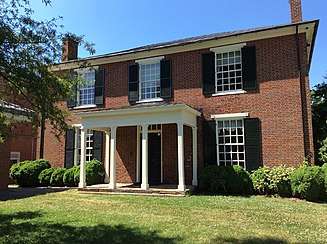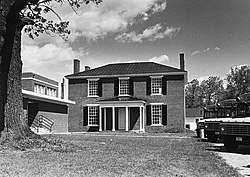New London Academy (Virginia)
New London Academy is a historic school located in Forest, Bedford County, Virginia. The rising of public schools after 1870 and closing down many of Virginia's private schools led New London Academy joining with the new public school districts of Campbell and Bedford Counties while remaining a private institution. This survival led to New London Academy being known as one of the oldest continuously running public schools of Virginia or even the South.[3] New London is set apart from other historic schools in its architecture, notable alumni, like Thomas Jefferson's grandson, and the religious aspects of the school.

New London Academy | |
 Front | |
  | |
| Location | Near jct. of VA 297 and VA 211, Forest, Virginia |
|---|---|
| Coordinates | 37°18′27″N 79°18′20″W |
| Area | 18.5 acres (7.5 ha) |
| Built | 1837-1839 |
| NRHP reference No. | 72001385[1] |
| VLR No. | 009-0047 |
| Significant dates | |
| Added to NRHP | April 13, 1972 |
| Designated VLR | December 21, 1971[2] |
History
In the late eighteenth century, New London, Virginia's hunger for education brought forth the need for proper education. Since the public school system had not been created yet, most schools were tuition-based academies. Thus, the New London Academy was chartered by the Virginia General Assembly in December 1795. With the charter, New London Academy could be seen as more trustworthy. Early in 1775, the Academy was established on its present campus near the former town of New London as a classical school for boys.Eventually, the school became co-educational in the 1870s and in the late-1880s became affiliated with the new public school system. New London Academy is the only public school in Virginia to operate under a charter from the General Assembly. New London Academy has gone through many changes structurally, in addition to the changing makeup of the school body. Religion also played a big factor in the history of the school.
Funding The School
In the early stages of the academy, the trustees at the academy hosted local lotteries in order to fund operations due to the lack of state funding. The Literature Lottery was an important source for many schools during this time period.[4] New London Academy held its first in 1797-1798 to collect funds for additional buildings and running the school. The lotteries allowed locals to be involved in helping the school. After 1818, the Academy was funded by the Literacy Fund, which was a State fund.[3]
Evolution of New London Academy
Throughout the years of operation, New London Academy's focus on education has changed:
- 1795-1870: New London Academy serves as a classical school for boys.
- 1870-1910: New London converts into a public school.
- 1910-1964: New London Academy becomes an agricultural high school.
- 1964–present day: New London Academy serves as an elementary school.
The Structures
The Original School Building
The original campus of 1795 consisted of a roomy academy building, president's house, a large enclosed brick church well, and the kitchen. Later in 1839, the original academy building was replaced by a two-story, brick building with a hipped roof, interior end chimneys, and enlarged windows. The structure was built in Greek Revival style.[4] It was listed on the National Register of Historic Places in 1972. The historic building originally had a square frame that would later be updated with a brick structure. It also used to have a porch in the front that had white square columns that were original to the structure.[5]
1797 Kitchen
Also on the property is a contributing frame kitchen building. The separate kitchen structure came into existence in 1797 because there was a danger of fire in having a kitchen connected to a bigger building. The original use, of course, was for the purpose of cooking so there is a central chimney that has two openings and hearths on either side of both rooms. Because of the nature of the large fireplaces being useful for cooking, the struggle was to actually heat the building, the fireplaces were much too large to accomplish that need. The kitchen structure has had many different uses. A few uses were as a storage shed and offices for the faculty staff at the academy. In 1890, the structure was used as a music studio.[3]
Thomas Hall
Thomas Hall was built as a boys dormitory in 1916–17, and was named for Principal O. A. Thomas. While the original plans for the dorm indicated that it would be a separate structure, the loan required that the money for construction had "...to be a renovation of, or an addition to, an existing building, not a new, freestanding structure."[6] The principal at the time, Robert Q. Lowry, was disappointed in this because of his personal vision for the campus of New London Academy. The structure was eventually demolished in 1970 though the building it was attached to still stands.[7]
Evans Hall
Evans Hall was built in 1873 as a replacement for the Principal's House, which burned to the ground in 1867. It was named after Miss Martha Evans, the dorm matron and a teacher, who left the school to teach in Concord, Virginia. While the approval for the new building was confirmed in 1869, construction did not occur until 1872, after the short stint New London Academy had in the new public school system.[8] During the time between the destruction of the original Principal's House and the construction of Evans Hall, it is unknown where the principals lived. Upon the construction of Evans Hall, which was built by J. W. Mays for $1,095.[9] Evans Hall, though initially a residence for the principal, served other purposes in the latter years of the Academy. In the 1880s, a primary school was operated by the principal's wife. In the 20th Century, the principal's residence would be moved to Thomas Hall, and Evans Hall would be used first as a boys dormitory and later as storage and utility.[10] In the 1960s, New London Academy was going through renovations and several buildings were demolished. Despite growing preservation efforts during the 1960s, Evans Hall was destroyed in 1964.[10]
Religion at New London Academy
While New London Academy has never been a religious academy at any point, though it has had religious connections in the past. First, the academy was affiliated with the New London Church or the Academy Church in the infancy of the school.[11] When a Reverend Thomas Brown became the principal of New London Academy, one of his curriculum textbooks he marketed to prospective parents was the use of the New Testament as a textbook, though he took care to note that the school would avoid being linked to any one church denomination.[12] Though there were no denominational links, one of the main goals of New London Academy and many schools at the time was to prepare the students for living completely, internally, externally and eternally. The school also hosted Vacation Bible School, and often let church organizations use the building, as some teachers were members of churches.[13] The students also participated and even ran school chapels and led devotionals for other students.[14] Students would also use religion to get out of class duties. A story noted in The Spirit of New London Academy goes as such. Ms. Coleman, a teacher at the academy was known for her passion for church and her disdain for the Revised Standard Version (RSV) of the Holy Bible. Students wanting to get out of their Latin lessons would ask her about the homily from the Methodist church, which she would gladly recite for the students. They would also ask her thoughts about the newest version of the Bible, the RSV, of which Ms. Coleman had many thoughts.[13] Many of the students of New London Academy went on to be ministers, reverends, or bishops like J.H. Rice, Nicholas H. Cobb, who became the principal, and Bishop John Early.[14]
Notable alumni
- Edward C. Burks (1821-1897) - American jurist.
- Wood Boulden (1811-1876) - American jurist.
- W. Harrison Daniel (1922-2013) - American historian.[15]
- Gordon Henry White, Jr. (1921-1944) - American army sergeant, killed with fellow "Bedford Boys" on D-Day.
- Francis W. Eppes (1801-1881) - Prominent planter and maternal grandson of Thomas Jefferson.
Notable Patrons
- Thomas Jefferson (1743-1846) - An honorable supporter of New London Academy and family to attendees.[3]
References
- "National Register Information System". National Register of Historic Places. National Park Service. July 9, 2010.
- "Virginia Landmarks Register". Virginia Department of Historic Resources. Retrieved 2013-05-12.
- Siddons, James (1994). The Spirit of New London Academy. Bowie, Maryland 20716: Heritage Books, Inc. pp. xiii–xiv. ISBN 1-55613-982-9.CS1 maint: location (link)
- "009-0047 New London Academy". www.dhr.virginia.gov. Retrieved 2019-02-13.
- "History of NLA - New London Academy". bedfordnla.sharpschool.net. Retrieved 2019-02-14.
- Siddons, James (1994). The Spirit of New London Academy. Bowie, MD: Heritage Books. p. 180.
- Siddons, James (1994). The Spirit of New London Academy. Bowie, MD: Heritage Books. p. 181.
- Siddons, James (1994). The Spirit of New London Academy. Bowie, MD: Heritage Books. pp. 168–9.
- Siddons, James (1994). The Spirit of New London Academy. Bowie, MD: Heritage Books. p. 171.
- Siddons, James (1994). The Spirit of New London Academy. Bowie, MD: Heritage Books. p. 172.
- Siddons, James (1994). The Spirit of New London Academy. Bowie, MD: Heritage Books. p. 226.
- Siddons, James (1994). The Spirit of New London Academy. Bowie, MD: Heritage Books. p. 227.
- Siddons, Jamea (1994). The Spirit of New London Academy. Bowie, MD: Heritage Books. p. 229.
- Siddons, James (1994). The Spirit of New London Academy. Bowie, MD: Heritage Books. p. 228.
- "W. Harrison Daniel". 7 June 2016. Retrieved 26 February 2018 – via Wikipedia.
External links
- New London Academy, 1133 Academy Lane, Forest, Bedford County, VA: 1 photo and 1 photo caption page at Historic American Buildings Survey

